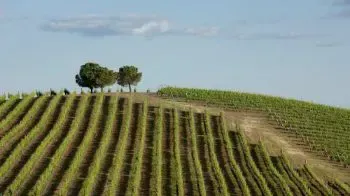The Alentejo Wine Region is located in southeastern Portugal, between the city of Portalegre and Beja, and is one of the largest wine regions in the country. It is a vast and varied region, however, only five percent of the region is dedicated to the production of wines. Because it is very sunny, it allows the perfect ripening of the grapes, but the very high summer temperatures make irrigation of the vineyard essential.

Image: Intermarché
Sub-Regions of the Alentejo Wine Region
The Alentejo Region is divided into eight sub-regions: Reguengos, Borba, Redondo, Vidigueira, Évora, Granja-Amareleja, Portalegre and Moura.
- Reguengos: it is the largest of the sub-regions of the Alentejo but, despite its size, it is more fragmented, with reduced average vineyard areas for traditional Alentejo references.
- Borba: it is the second largest sub-region in Alentejo.
- Redondo: it is one of the most consistent sub-regions thanks to the protection that Serra da Ossa offers.
- Vidigueira: it has been a privileged place for white wines from Alentejo for several years thanks to its temperate climate.
- Évora: at the end of the 19th century it was recognized as one of the most striking and admired sub-regions of the Alentejo, home to many of the region's most coveted wines.
- Granja-Amareleja: it is known for being the sub-region where the Moreto variety is planted.
- Portalegre: it is the sub-region that most differs in terms of originality and condition. Here, more fresh and refined wines are produced.
- Moura: located further inland, it presents wines with a warm and soft profile. The Castelão variety dominates the sub-region, well adapted to the rigors of such an extreme climate.
Types of wine and grape varieties in the Alentejo Wine Region
The most planted red grape varieties in this region are: Trincadeira, Aragonez, Castelão and Alicante Bouschet. The white grape varieties are: Roupeiro, Antão Vaz and Arinto.
Alentejo red wines are full-bodied, rich in tannins and with aromas of wild and red fruits. Whites are usually mild, slightly acidic and have aromas of tropical fruits.
Terroir of the Alentejo Wine Region
In the northeast corner, around the city of Portalegre, the climate is much colder than in the rest of the Alentejo and is an area with great potential for making more elegant wines. The center of Alentejo, a wide area that encompasses the cities of Évora, Borba, Estremoz and Reguengos, is warmer and makes wines with a good balance of acidity. In the south of the Alentejo region, in the sub-regions of Moura, Vidigueira and Granja-Amareleja, the climate is warmer and drier, where structured, firm and full-bodied wines are produced.

Image: Folclore.pt
Harmonization of Alentejo wines with food
Red wines from the Alentejo are acidic, usually cut fat, so they go very well with fatty red meat dishes. In the white wines of Alentejo we find freshness and tropicality, they are great companions for soft cheeses, fish dishes and even some pot dishes based on white meats, not very stewed tomatoes and beans.
 Portugal
Portugal Spain
Spain France
France Germany
Germany United Kingdom
United Kingdom Monaco
Monaco



